
Every now and again a restoration comes along that redefines what can be expected in terms of the resurrection of classic yachts. At one time it was satisfactory to sheathe classic yachts in GRP below the waterline and there was also a fad for “modernising” historic craft, thereby obliterating their true heritage. Of course, all manner of adjustments and trickery seem still to be justified in the name of winning races; and to some it is still reasonable to simply close the shed doors on a rebuild and produce a new yacht while throwing away all that remains of the old. But these are other stories and most of these ideas, thankfully, have been surpassed by hard-working craftsmen striving to produce restoration perfection. The relaunch of the Fife III, First Rule 8-Metre, Ierne, in 2008, went a long way towards redefining what levels of authenticity, purity and craftsmanship could be expected, and this was achieved far way from the big-name restoration yards.
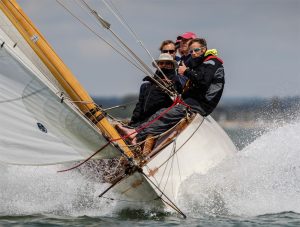
It’s fair to say that the Ierne project has put its shipwright, Joe Irving of Draughtsman Yachts, Barton upon Humber, onto the classic restoration map – if there is one. Not least because any map of the UK’s renowned yacht restorers would not have had much colouring-in around Joe’s native East Yorkshire. But this is where the project was completed in its entirety, pulling in resources from the surrounding area whenever possible, and it was by far the largest project that Joe had undertaken to that time. When it was completed the restoration project gained wide acclaim for its quality and authenticity, and Ierne was rightly awarded the Classic Boat magazine Restoration of the Year prize in 2008 for owner Huw Morris-Jones and shipwright Joe Irving – both East Yorkshire residents.
Joe is a graduate from the boatbuilding training college, IBTC in Lowestoft, UK and on leaving the college he quickly built a strong reputation locally for beautiful, performance-based rebuilds of many of the local fleet of Yorkshire One-designs based at the Bridlington Yacht Club. Having seen Joe’s work on his own YOD, Huw Morris-Jones believed in Joe’s ability to carry out a project on the much larger scale of an 8-Metre Fife racing yacht. Joe squared the circle by maintaining his notorious attention to detail over this vaster scale.
It was, in fact, Joe who had put Huw and Ierne together through a contact he made during his time at IBTC, where a Portuguese sailor, Antonio Correia, was learning the skills he would need to rebuild the yacht he had owned and loved for 20 years – that yacht was Ierne. One thing that his time at IBTC taught Antonio was that the amount of time, effort and money it was going to take to do justice to rebuilding one of the world’s most sought-after historic racing machines was vastly greater than he had imagined. Huw stepped in and bought the boat from Antonio with the promise of a full and prompt return to the water.
When the yacht was repatriated to the UK, the low-loader headed straight for Joe’s Irving’s yard, where stripping commenced immediately. The previous assessment of work required was rapidly superceded by a schedule of much greater complexity once the true extent of the ravages to the hull that 80 years afloat and 10 years in a Portuguese farm shed had been revealed. What had once been planned as a refit became a full-scale restoration.
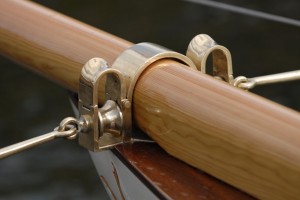
Fairlie Restorations of Hamble, keepers of the majority of what remains today of the Fife document archive, found some of the original drawings and sail plans as well as authentic patterns for fixtures and fittings, while innumerable links were forged to local craftsmen for items such as metal floors, bronze castings and exotic timber. The project rumbled into life and the boat that had not sailed for more than a decade hit the water in 2008, just in time for that year’s Fife reunion on the Clyde in Scotland.

Originally built for renowned Irish yachtsman, Arthur F Sharman-Crawford – of the family that owned the brewers of Beamish Stout, and sailing adviser to Sir Tomas Lipton – the 1914-built First Rule 8-Metre Ierne was one of a series of four racing yachts, all at some stage named Ierne, that Sharman-Crawford had built by William Fife III between 1910 and 1920. The yacht restored by Huw Morris-Jones is the third in that series and the second 8-Metre, yard No 638. She was the only one listed as still owned by AF Sharman-Crawford at the outbreak of WWI, in 1914. It seems that she spent the war, along with many other distinguished European yachts, in Scandinavia, as she re-emerges after the hostilities in Christiania, now Oslo, Norway in the ownership of a Magnus Korrow, by whom it is reputed that she was sailed to the gold medal at the 1920 Olympic Games.
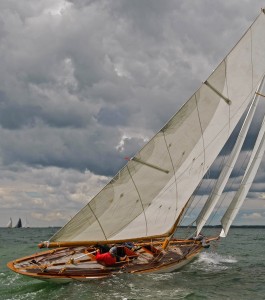
Her original rig was one of Fife’s early forays into the bermudan arena and was somewhat willowy – Sharman-Crawford had three masts built for her in her first season alone – and this was an area that required careful analysis during her rebuild: though there was a quest for purity, a requirement to achieve a useable yacht also prevailed. And so yacht historian Theo Rye was asked to design a rig that was both historically accurate as well as practical for today’s sailing demands.
It seems that early in her existence, a number of alternative rigs had been mooted by Fife, perhaps because her rig was considered weak, but also at least one incorporating a short club-gaff rig to accommodate changes made to the 8-Metre rule. These rig drawings refer to a number of other yachts as well as Ierne and contain a series of historical amendments and up-dates, so it took Theo Rye plenty of head scratching to unravel the story. In the end he deciphered the notes and amendment details, concluding with the analysis: “As a possible sequence we could envisage Ierne’s owner approaching Fife in June 1914, having had at least one mast fail, and asking him for a solution; at which point Fife looked at putting a gaff rig into her, but the outbreak of WWI perhaps postponed this change.”
“We can conclude that the ‘club’ gaff rig shown on the original plans was an exercise investigating how to make Ierne rate under the Second Rule, in March 1920, as it refers to a “Maximum Height” for the rig and the calculation of the foretriangle area uses a 0.85 factor, both of which were features of the Second Rule.
The sail plan that Theo Rye produced for the rebuilt Ierne was based closely on the original 1914 drawings, though with a reduction in overall area to compensate for increases in LWL and displacement brought about by the inclusion of an engine, while still allowing her to rate at 8-Metres. In addition, a second set of spreaders has been added in keeping with current best-practice regarding 8-Metre rigs, and to-date the rig has proved stable and powerful in all sailing.
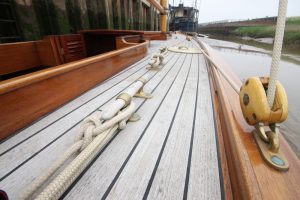
Today, sympathy and simplicity reign aboard Ierne, exactly as when she was first launched, and these were the twin themes that Huw Morris-Jones maintained throughout the rebuild. Internally, accommodation is to a high quality, but spare, as befits a pedigree racing yacht. Simple varnished slats finish off the hull interior in a practical and pretty fashion, while cushioned side-bunks provide what’s necessary to make staying aboard during regattas feasible. But it’s on deck and underway that Ierne comes to life.
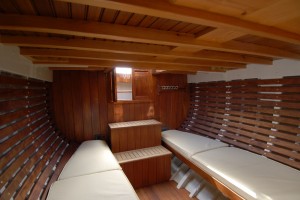
It’s believed that Ierne‘s hull design is as close to hydro-dynamic perfection as could be achieved at the time of her build and to some she is rated as the ultimate First Rule 8-Metre. She leaves virtually no wake as she slips through the water and exhibits many of the distinctive Fife characteristics.
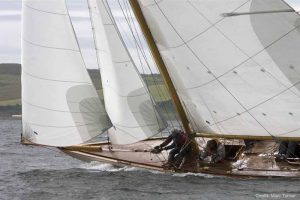
In large part, Fife derived Ierne’s performance by producing a narrow hull form (maximum beam is just 7ft 7in with LOD of 45ft) combined with lots of tumblehome while, in keeping with the drive for originality, no winches clutter her decks and navigation equipment has been kept to the barest minimum. Her deck layout is a simple blend of the necessities required to sail fast combined with a breath-taking quality of workmanship and finish. To look along the deck while sat at the tiller gives a helmsman the sense of being in control of something very special.
The lack of modern aids, means that she takes some attention to detail in order to get the best performance out of her, but the benefits include exhilarating speed and the glee derived from feeling what it’s like to sail a true historic yacht.
To be able to say “I own a Fife” is one thing, but to be able to sail a yacht that feels close to what Fife intended: to pick up the feeling of vitality through the tiller, or the electricity of out-and-out sailing performance, can only be achieved by returning a yacht as nearly as possible to a designer’s original intentions. Ierne gets closer to this purity than most have dared.
